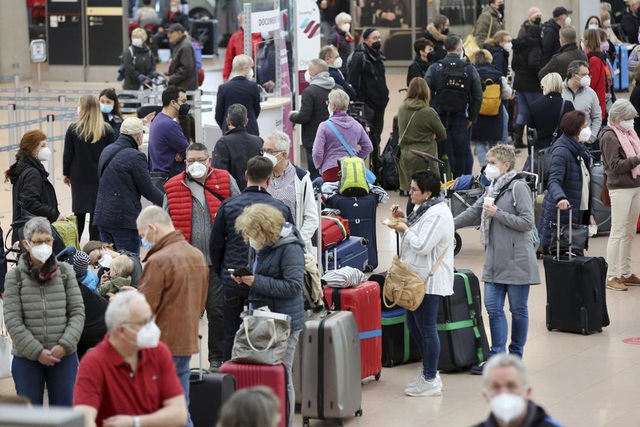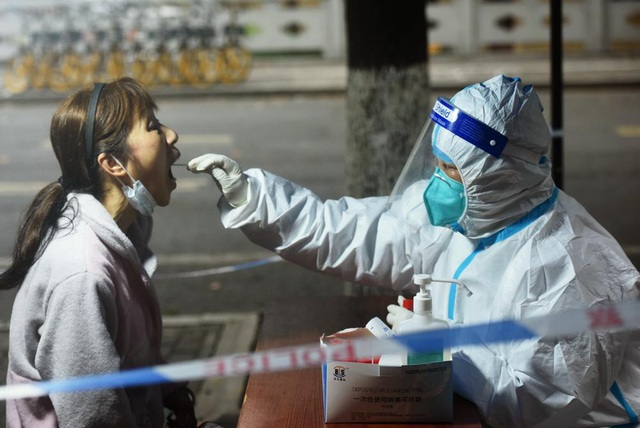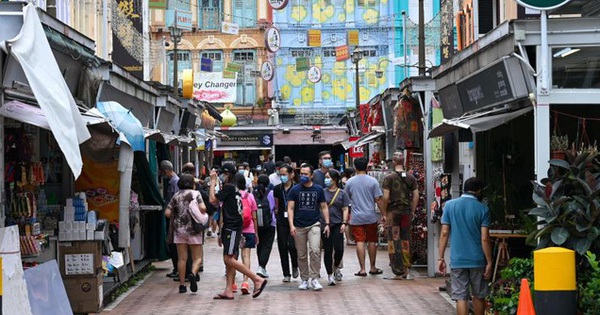China copes with the largest epidemic wave, South Korea has over 600,000 new cases for 2 consecutive days
More than 465.36 million people worldwide have contracted the SARS-CoV-2 virus. (Photo: AP)
The country most affected by the epidemic COVID-19 still America with over 81.3 million cases and more than 995,400 deaths. In the past day, the US recorded an additional 12,600 people SARS-CoV-2 virus infection.
At the world’s second largest COVID-19 epidemic center Indiaon March 17, the country recorded a total of over 43 million people with COVID-19, including more than 516,000 deaths from COVID-19 in this South Asian country.
India has expanded its COVID-19 vaccination program with the introduction of the vaccine for adolescents aged 12-14 years and lifted restrictions on booster doses for those over 60 years of age. Indian Prime Minister Modi has urged people in these age groups to get vaccinated. The Indian government estimates that around 50 million children will receive two doses of the Corbevax vaccine produced by a local company. The two injections will be given 28 days apart.
Brazil Currently, it is the world’s 3rd largest epidemic hotspot with more than 656,000 COVID-19 patients dying out of a total of over 29.47 million infected people in this country.
On March 17, the UK approved AstraZeneca’s antibody-based COVID-19 prophylactic therapy. This therapy is for adults with weakened immune systems. This is the world’s first monoclonal antibody licensed for the prevention of COVID-19.
The test results showed that the monoclonal antibody mixture Evusheld has the ability to prevent symptoms up to 77%, with a protective effect within 6 months after only 1 dose, which is considered superior to vulnerable subjects to the SARS-CoV-2 virus. Evusheld is the only monoclonal antibody currently available for intramuscular use and is indicated for pre-exposure prophylaxis to SARS-CoV-2.
From April 1, the Government Canada will end the pre-entry testing requirement for fully vaccinated travelers with the COVID-19 vaccine who arrive in the country by air and by land. However, random testing on arrival in Canada will still be done to monitor for new variants. Currently, Canadian airlines are increasing recruitment of staff and adding additional routes for the coming months to prepare to welcome international visitors to the country.
According to official statistics, the total number of COVID-19 infections in Canada currently exceeds 3.37 million, of which over 37,000 people have died.
Concerned about the number of COVID-19 cases continuing to increase sharply in recent days, many states in virtue hesitant to lift restrictive measures to fight the epidemic, scheduled for March 20.
Many states across the country are planning to use a provision in the “new infection protection law” that provides for a two-week transition period after most of the epidemic prevention measures are lifted on March 20. . Previous regulations such as the mask requirement or the 2G (vaccinated or recovered from COVID-19) and 3G (vaccinated or recovered from COVID-19 or negative test) rules count) may still apply until April 2.

Many states in Germany are hesitant to lift restrictive measures. (Photo: AP)
Over the past few days, the number of new COVID-19 cases has continuously “peaked” and made many states hesitant to repeal current regulations. According to statistics from the Robert Koch Institute, the rate of COVID-19 cases in the past 7 days in Germany was 1,607.1 cases per 100,000 population, the highest level since the outbreak of the pandemic. In the past 24 hours, the country has recorded 279,234 new cases, bringing the total number of people infected in Germany to over 18.12 million cases.
From March 17th, Cambodia began issuing regulations to remove COVID-19 medical requirements upon entry into the country to attract international visitors. The Cambodia Inter-ministerial Committee for COVID-19 Prevention and Control chaired by the Ministry of Health has announced a number of important contents related to Cambodia’s immigration regulations.
According to the announcement, Cambodia waives the procedure to present negative PCR test results within 72 hours and also waives rapid testing for visitors entering Cambodia. Besides, Cambodia will re-issue entry visas to all international tourists, including tourists by air, land and waterway.
However, all passengers must present a certificate of vaccination against COVID-19 vaccine, otherwise entry must be isolated for 14 days at a location specified by the Ministry of Health of Cambodia.
Government Thailand It is expected to allow travelers to enter the country without presenting proof of a negative PCR test within 72 hours of departure. Guests will only need a PCR test on arrival and self-antigen testing on the 5th day of arrival. In addition, the health insurance limit for foreign tourists will be reduced from at least $50,000 to $10,000.
It is expected that a detailed plan of steps for Thailand to downgrade the COVID-19 pandemic to an endemic disease will also be submitted at the meeting of the Center for Handling the COVID-19 Situation on March 18.
Number of new cases of COVID-19 in South Korea For the first time, it exceeded 600,000 cases/day on March 16. The number of new cases increased by 55% from the previous day and most of them were community transmission. Meanwhile, on March 17, South Korea recorded a record 621,328 new COVID-19 infections and 429 deaths.
South Korea is at the peak of the most severe infection wave. Cremation facilities are overcrowded due to the rapid increase in the number of deaths. Faced with the rapid spread of the Omicron variant, Korea is also facing a serious shortage of conventional medicines. The country’s media reported that many private medical facilities in Seoul now no longer have common medicines to prescribe to patients such as cold medicine, cough suppressant, expectorant syrup. The number of COVID-19 patients being treated at home in South Korea has reached about 1.6 million, and as a result, medicines to treat common colds have also become scarce.
Special administrative region government Hong Kong (China) is trying to control the 5th outbreak since December 2021, when the Omicron variant spread widely, putting pressure on the city’s health system. Many hospitals are currently overwhelmed with the volume of patients with COVID-19, while morgues and funeral homes are also under great pressure. According to researchers, up to now, nearly 50% of the total 7.4 million people of this special administrative region have been infected with COVID-19.
Although this outbreak peaked on March 4, it is estimated that the number of people infected with COVID-19 could reach 4.5 million before this wave ends. Researchers predict that by May 1, the number of deaths from COVID-19 in Hong Kong will exceed 5,000 people. To date, this special zone has recorded a total of over 975,000 cases and nearly 5,000 deaths, most of which were recorded in the past 3 weeks.

Hong Kong is currently struggling with a serious outbreak. (Photo: AP)
On March 17, President China Xi Jinping has urged to upgrade the level of disease control and prevention in the context that the world’s most populous country is dealing with the largest wave of disease since the COVID-19 outbreak in the country at the end. 2019.
According to China Central Television, while presiding over the Politburo meeting, Xi stressed that China must curb the spread of the COVID-19 epidemic as soon as possible while still complying with the law. policy “Zero COVID-19”. According to the Chinese leader, the country must upgrade the level of epidemic control and prevention as well as continue to optimize the current epidemic prevention and control measures. In addition, President Xi Jinping also called for speeding up the vaccination program, rapid testing and research into treatment drugs to prevent epidemics.
Just three weeks ago, China recorded fewer than 100 COVID-19 cases per day. However, this number has increased past 1,000 cases / day in the past 1 week. For more than a year, the country has also not recorded any new deaths from COVID-19 thanks to tight epidemic prevention measures. However, the contagious Omicron variant is posing a challenge to the “Zero COVID” policy, which has forced Chinese cities, including Shenzhen, the southern technology hub of the country, to impose lockdowns while other cities announced tightening restrictions.
According to research results of British scientists, less than 1% of babies will test positive for SARS-CoV-2 virus if their mothers have COVID-19. The results are based on a synthesis and analysis of nearly 500 studies involving 29,000 pregnant women. This is the most comprehensive study to date, thereby providing the most comprehensive insight into the risk of mother-to-child transmission of the SARS-CoV-2 virus during pregnancy. Out of 592 infants with complete data on how and when they contracted COVID-19, only 7 were infected while in the womb and 2 were infected at birth.
According to scientists, the study provides reassurance for parents when it finds that less than 1% of newborns test positive for the SARS-CoV-2 virus in the first 48 hours after birth. life. In addition, the team did not find any link between newborns being positive for SARS-CoV-2 and breastfeeding.
If symptoms persist for only 1 month after recovering from COVID-19, it is not considered post-COVID-19. This is explained by the Clinical Management team at the World Health Organization (WHO). Accordingly, for the post-COVID-19 period, symptoms usually last for 2 months or more. The most common are 3 symptoms including fatigue, shortness of breath and cognitive dysfunction causing brain fog (with manifestations of memory impairment, inability to concentrate).
Therefore, the most suitable time to have a post-COVID-19 examination is about 3 months after contracting the disease. According to WHO experts, there is no universal treatment for all cases, but must focus on each person’s symptoms. There are currently no drugs to treat Post-COVID-19 complications but only interventions such as rehabilitation, quality of life improvement…
The World Health Organization (WHO) on March 17 sounded the alarm about the sudden increase in the number of new cases of COVID-19 globally, despite the decline in testing rates and the number of new cases recorded continuously. continued to decline in recent weeks. WHO has expressed concern about the sharp increase in the number of new cases, especially in Asia.
The agency called on countries to quickly expand vaccination coverage, as well as carefully consider plans to remove epidemic prevention measures. The WHO said that by far, Omicron is still the most infectious variant and the factors that make the epidemic spread quickly are the removal of health measures such as wearing masks, social distancing and restrictions by countries. travel restrictions, as well as the fact that countries have not completed vaccination coverage campaigns.
* Invite readers to watch programs broadcast by Vietnam Television on TV Online and VTVGo!
at Blogtuan.info – Source: vtv.vn – Read the original article here



